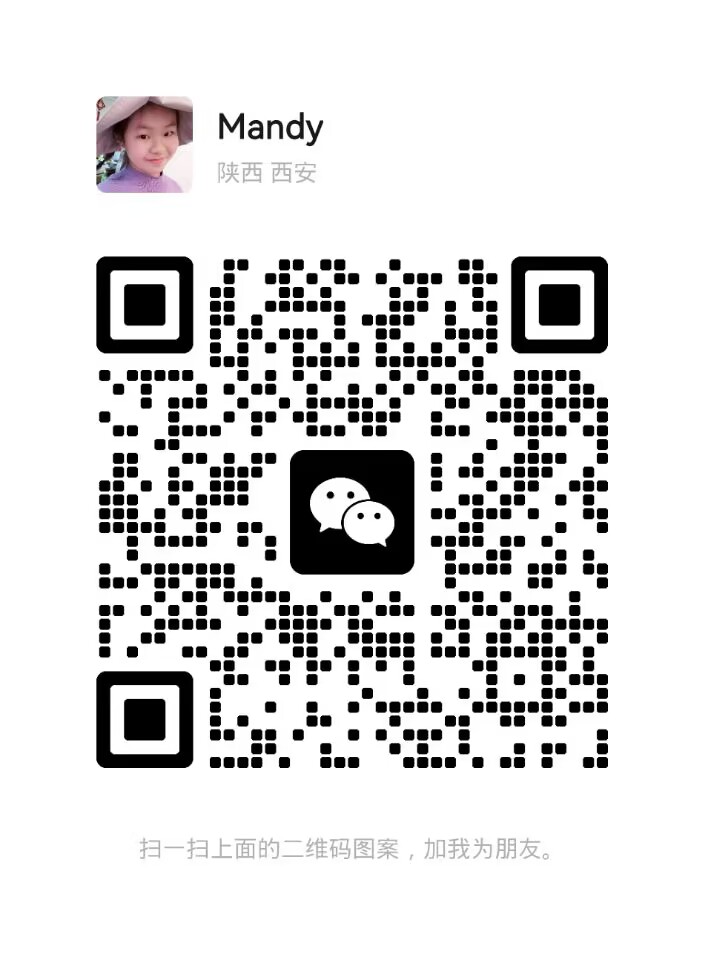Bearing selection criteria
Bearing type characteristics
A wide range of bearing types is available
There are a wide range of bearing types available from which the designer can select the bearing that best suits his or her needs. However, due to the diversity of applications and the different effects on the bearing position, it is impossible to give here generally applicable rules for the selection of bearing types. Several criteria usually need to be weighed when deciding on a specific bearing type.
Factors that are usually important in bearing selection
The following descriptions are intended to help the designer. Reference is made to the factors that play a major role in the selection of bearing types. For more precise data on the individual bearing types, characteristics and available designs, refer to the specific product chapters.
Bearing type selection criteria
Product characteristics that can play a role in the selection of bearing types are listed on the left
Bearing type design comparison
In many applications, the main dimensions of rolling bearings are usually determined by the overall design of the machine or equipment.
Bearings for small and large diameter shafts
For small diameter shafts, the most suitable bearings are ball bearings, especially deep groove ball bearings and needle roller bearings. In the case of large diameters, available bearings are cylindrical roller bearings, tapered roller bearings, spherical roller bearings and toroidal roller bearings, as well as deep groove ball bearings and needle roller bearings.
Comparison of cylindrical roller bearings A narrow bearing with a large outside diameter and a wide bearing with a small outside diameter can both achieve approximately the same load carrying capacity.
| The basic load ratings C0 of the three sets of cylindrical roller bearings are roughly the same. Among them, SL183026 is a full-complement cylindrical roller bearing. | 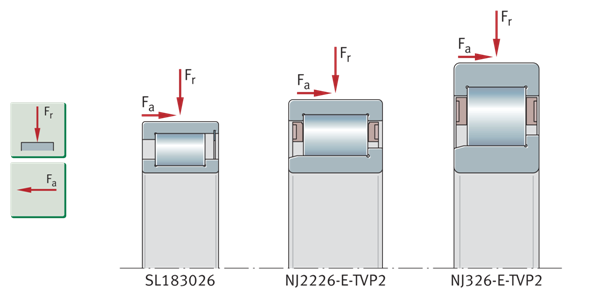 |
Bearings with small cross-section height
Low section height and high load capacity
If the bearing load is limited in the radial direction, such as in high-performance gearboxes in vehicles, bearings with a smaller cross-sectional height may be used preferentially, such as needle roller and cage assemblies, drawn cup needle roller bearings, etc. These bearings have a higher radial load capacity due to the lower cross-sectional height of the line contact.
Comparison of radial section heights for bearings with smaller section heights Needle roller and cage assembly Open stamped outer ring needle roller bearings Needle roller bearings without inner ring Needle roller bearings with inner ring | 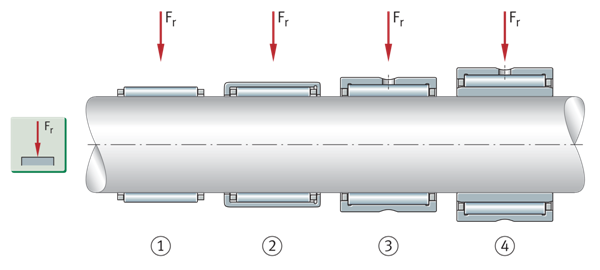 |
Bearings with small axial space and combined loads
If the bearing design is small in the axial direction, it is appropriate to use some series of cylindrical roller bearings, such as NJ series semi-locating bearings and deep groove ball bearings or combined needle roller bearings.
Semi-locating bearings used in conjunction with deep groove ball bearings to support axial forces in one direction Cylindrical roller bearings NJ series (semi-locating bearings) Deep groove ball bearings (locating bearings) | 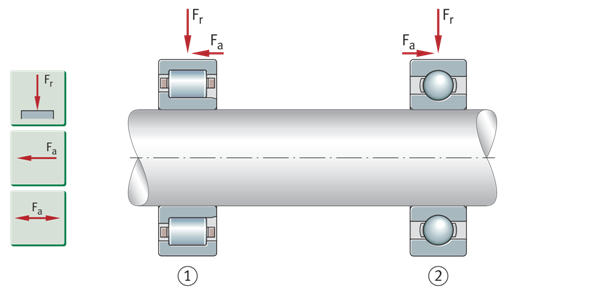 |
Combined needle roller bearings for supporting high radial and axial forces in one or two directions Needle roller/axial deep groove ball bearings without inner ring and without end caps for unidirectional axial forces Needle roller/angular contact ball bearings with inner ring for axial forces in two directions | 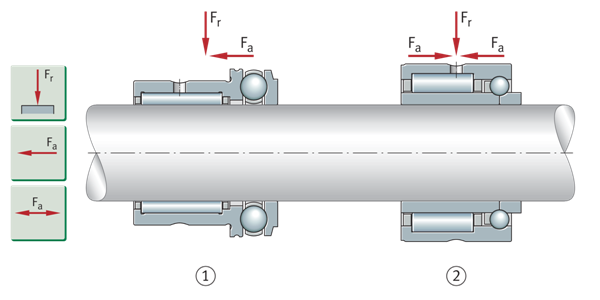 |
Bearings with pure axial load capacity
If the bearing is only subjected to axial loads, suitable bearings are axial needle roller and axial cylindrical roller and cage assemblies, axial needle roller and radial cylindrical roller bearings, and axial deep groove ball bearings with a small axial section height.
Axial bearings - cross-section comparison Axial needle roller and cage assembly Axial needle roller bearings Axial deep groove ball bearings Axial cylindrical roller bearings | 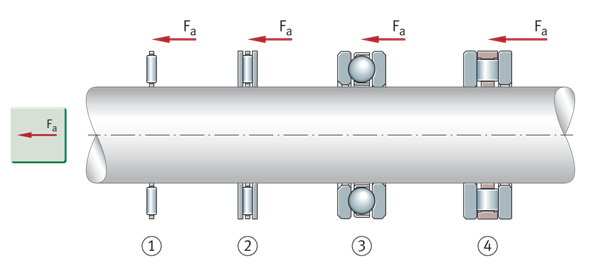 |
Load value and load direction
Effect of loads on bearing type and bearing size
Load determines bearing type and size
Bearing size is usually determined by external loads, and when selecting a bearing, it is important to note that roller bearings can handle higher loads than ball bearings of the same size due to line contact.
Radial load capacity - comparison of deep groove ball bearings and cylindrical roller bearings Deep groove ball bearings lower radial load capacity Cylindrical roller bearings NU series higher radial load capacity | 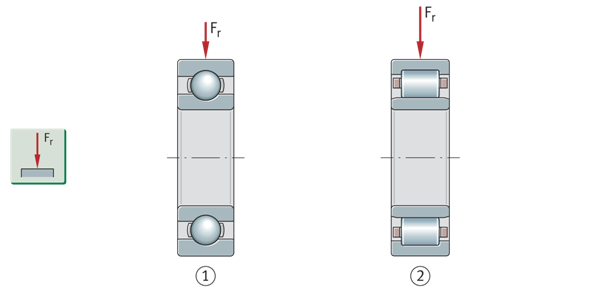 |
Bearings used primarily for radial loads
In the case of radial loads, the forces are perpendicular to the bearing axis
If there are radial loads (so-called transverse forces), which are forces perpendicular to the longitudinal axis, bearings that exclusively or primarily support radial forces are used, such as radial ball bearings and radial roller bearings.
Cylindrical roller bearings of the N and NU series, needle roller and cage assemblies, drawn cup needle roller bearings with open ends, needle roller bearings and toroidal roller bearings can only accommodate radial forces.
Radial bearings, i.e. bearings mainly used to bear radial loads Open deep groove ball bearings Angular contact ball bearings Cylindrical roller bearings NU series Tapered roller bearings Spherical roller bearings | 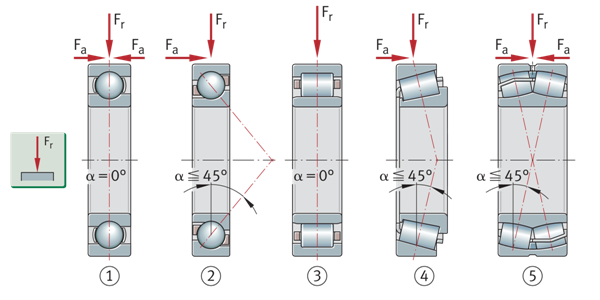 |
Bearings mainly for axial loads
If there are mainly axial forces (forces in the direction of the shaft) - use bearings that mainly support the axial forces.
Low to medium axial loads
If there are low to medium pure axial loads, suitable bearings are axial deep groove ball bearings and four-point contact bearings, if there are axial loads in one direction, single-direction axial deep groove ball bearings can be used.
Medium to high axial loads
If there are medium to high axial loads in one direction, suitable bearings are axial needle roller bearings, axial cylindrical roller bearings, axial tapered roller bearings and axial spherical roller bearings. Axial cylindrical roller bearings or axial spherical roller bearings arranged next to each other in pairs are suitable for high axial loads in alternating directions.
Mainly used for bearings with axial loads Axial deep groove ball bearings, one-way Axial angular contact ball bearings, double row, double direction Axial needle roller bearings, one-way Axial cylindrical roller bearings, one-way Axial spherical roller bearings | 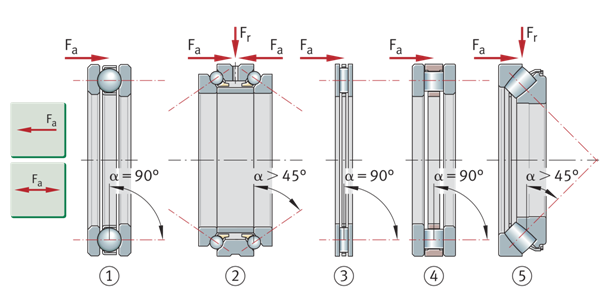 |
Bearings for combined loads
Some rolling bearings may be subject to combined loads (radial and axial).
The axial load capacity of a bearing is determined by the nominal contact angle . The larger this angle, the higher the axial load capacity of the bearing. Its axial load capacity is also indicated by the bearing-specific axial load factor Y in the product table; the smaller this factor, the higher the axial load capacity.
Bearings for combined loads
Suitable bearings are deep groove ball bearings, four-point contact bearings, single-row and double-row angular contact ball bearings, spherical roller bearings and single-row tapered roller bearings. Self-aligning ball bearings and cylindrical roller bearings NJ (semi-locating bearings) and NU (locating bearings) + L-ring HJ (=semi-locating bearing units) can also be used.
Axial loads existing in one direction can only be supported by single-row angular contact ball bearings and tapered roller bearings, cylindrical roller bearings NJ as well as NU+HJ and axial spherical roller bearings. For alternating load directions, these bearings must always be mounted together with a second bearing (which must provide support in the opposite direction). For mounting in groups, matched single row angular contact ball bearings or matched tapered roller bearing sets consisting of two individual bearings can be used.
Combined load bearings Deep groove ball bearings Four-point contact ball bearings Single row angular contact ball bearings Double row angular contact ball bearings Tapered roller bearings Spherical roller bearings | 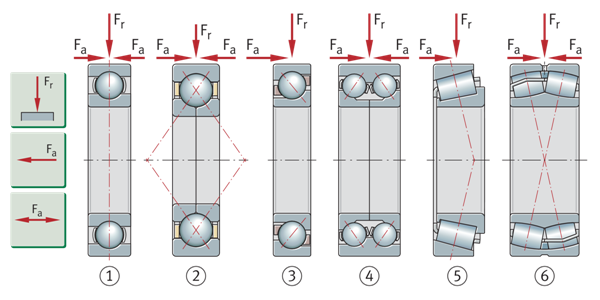 |
Combined load bearings Self-aligning ball bearings (locating bearings) Cylindrical roller bearings NJ (semi-locating bearings) Cylindrical roller bearings NUP (locating bearings) Cylindrical roller bearings NJ+HJ (locating bearings) Cylindrical roller bearings NU+HJ (semi-locating bearings) | 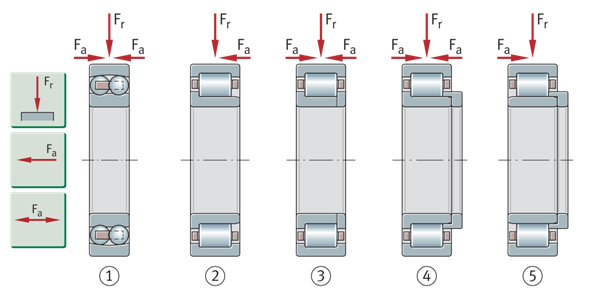 |
Axial loads can also be supported by separate bearings
If the axial load component is too high, the axial load can also be supported by separate bearings. In addition to pure axial bearings, radial bearings such as deep groove ball bearings and cylindrical roller bearings or four-point contact bearings can be used to support axial forces in both directions.
If a four-point contact bearing is used only as an axial bearing, the outer ring must have radial clearance in the housing.
Cylindrical roller bearings and four-point contact ball bearings for supporting combined loads Cylindrical roller bearings NU, radial bearings Four-point contact ball bearings, axial bearings (if the bearing is subjected to pure axial loads, the outer ring must not be retained radially) | 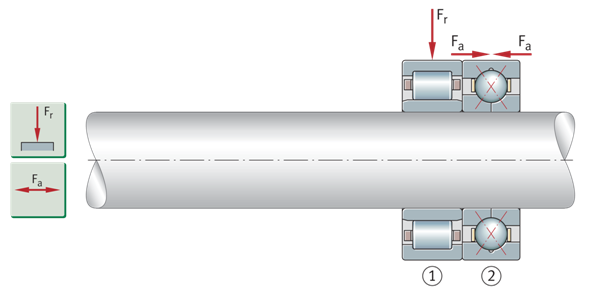 |
Bearings for supporting tilting moments
Temperature loads due to eccentric forces
If the load is eccentric, the bearing is subject to tilting moments. In addition to double-row deep groove ball bearings and angular contact ball bearings, single-row angular contact ball or tapered roller bearings paired face-to-face or back-to-back are suitable in this case.
Bearings used to support tilting moments M = tilting moment Double-row angular contact ball bearings Angular contact ball bearing set, including two matching single-row angular contact balls, O-type pairing Tapered roller bearing set, including two matching single-row tapered roller bearings, X-type arrangement | 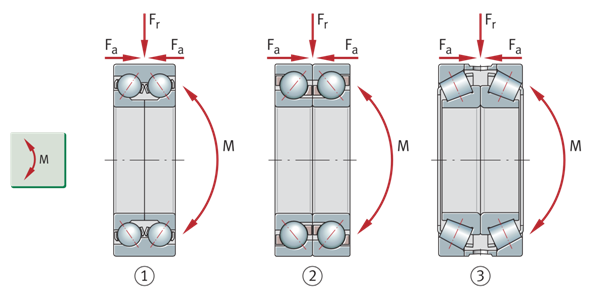 |
Double-row deep groove ball bearings
The tilting moment generated by the eccentric force F is supported by double-row deep groove ball bearings.
One-way bearing arrangement M = tilting moment F = radial force due to eccentric action Double row deep groove ball bearing | 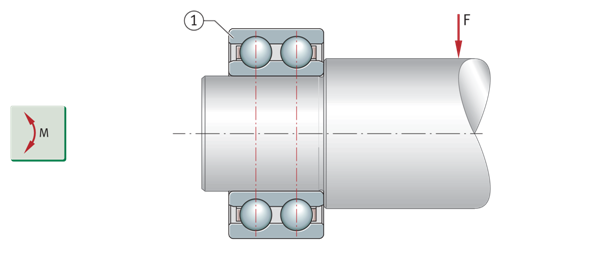 |
Speed
High-speed and very high-speed bearings
Permissible speed limited by operating temperature
In general, the maximum speed achievable in rolling bearings is determined by the permissible operating temperature. This depends on the friction heat generated in the bearing, the heat from external sources and the heat dissipated from the bearing arrangement. When conditions are in equilibrium, the bearing temperature is constant.
High-speed bearings
The highest speeds are achieved with single-row bearings with particularly low friction. Under pure radial loads, open deep groove ball bearings are used, while under combined loads, angular contact ball bearings are used
Due to their design, the permissible speeds for axial bearings are usually lower than those for radial bearings.
High speed and ultra-high speed bearings Deep groove ball bearings, single row, open type Angular contact ball bearings, single row, open type | 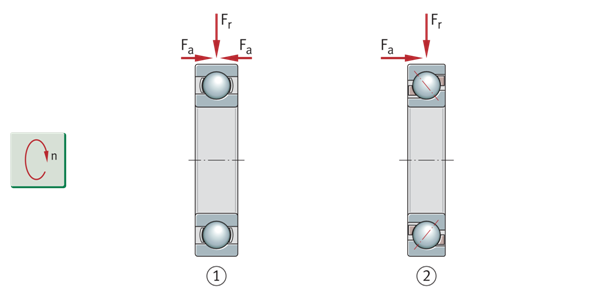 |
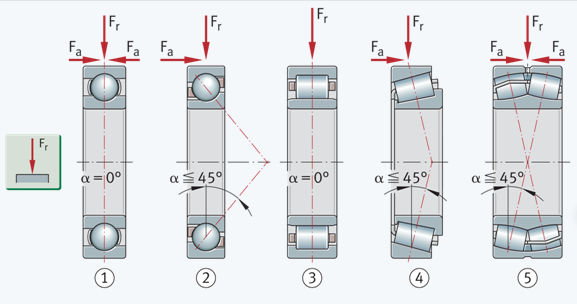
1.The news above mentioned with detailed source are from internet.We are trying our best to assure they are accurate ,timely and safe so as to let bearing users and sellers read more related info.However, it doesn't mean we agree with any point of view referred in above contents and we are not responsible for the authenticity. If you want to publish the news,please note the source and you will be legally responsible for the news published.
2.All news edited and translated by us are specially noted the source"CBCC".
3.For investors,please be cautious for all news.We don't bear any damage brought by late and inaccurate news.
4.If the news we published involves copyright of yours,just let us know.
Next A New Process for Differential Gear Manufacturing
BRIEF INTRODUCTION
Cnbearing is the No.1 bearing inquiry system and information service in China, dedicated to helping all bearing users and sellers throughout the world.
Cnbearing is supported by China National Bearing Industry Association, whose operation online is charged by China Bearing Unisun Tech. Co., Ltd.
China Bearing Unisun Tech. Co., Ltd owns all the rights. Since 2000, over 3,000 companies have been registered and enjoyed the company' s complete skillful service, which ranking many aspects in bearing industry at home and abroad with the most authority practical devices in China.


















